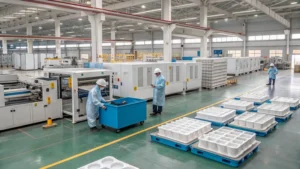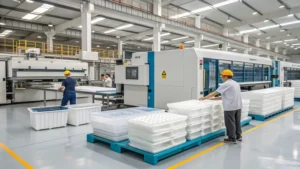
Smart sensors are revolutionizing how we interact with and manage our environments by providing instantaneous data collection, processing, and transmission. These advanced devices integrate sensing capabilities with on-board processing and communication technologies, making them indispensable for real-time monitoring1 across various industries.
Smart sensors enable real-time monitoring by detecting physical properties, processing data locally, and transmitting it wirelessly, enhancing efficiency in applications like industrial automation, healthcare, and smart cities.
Understanding the role of smart sensors2 in real-time monitoring is essential for leveraging their benefits in your field. This blog post dives into their definitions, classifications, applications, technical workflows, practical design tools, and related technologies, offering a comprehensive guide for both novices and professionals.
Smart sensors reduce operational costs in monitoring systems.True
By processing data locally, smart sensors decrease the need for extensive data transmission and centralized processing, lowering operational expenses.
Smart sensors are only useful in industrial settings.False
Beyond industry, smart sensors are widely used in healthcare, smart homes, agriculture, and smart cities, showcasing their versatility.
- 1. What Are Smart Sensors?
- 2. What Are the Applications of Smart Sensors in Real-Time Monitoring?
- 3. What Are the Steps in the Smart Sensor Workflow?
- 4. What Are the Key Factors in Smart Sensor Performance?
- 5. How Do You Design Smart Sensors for Real-Time Monitoring?
- 6. What Are the Related Technologies?
- 7. Conclusion
What Are Smart Sensors?
Smart sensors are advanced devices that combine sensing, processing, and communication capabilities to monitor physical environments in real time. They go beyond traditional sensors by analyzing data on-board and transmitting actionable insights, often wirelessly, to support immediate decision-making.
Smart sensors integrate sensing, processing, and communication to provide real-time data for industries like manufacturing, healthcare, and environmental monitoring, improving accuracy and responsiveness.

Definition and Core Principles
A smart sensor is defined as a device that detects physical properties—such as temperature, pressure, or motion—and uses built-in computational resources to process this data before transmission What is a Smart Sensor and How Does it Work? | TechTarget. Known as intelligent or semantic sensors, they filter noise, perform local analytics, and communicate efficiently, making them ideal for real-time applications.
Classification of Smart Sensors
Smart sensors can be categorized based on several criteria:
| Classification Type | Categories | Notes |
|---|---|---|
| Measurement Type | Temperature, pressure, motion, gas | Tailored to specific physical properties |
| Communication Method | Wired, wireless (Wi-Fi, Bluetooth) | Wireless is prevalent for flexibility |
| Power Source | Battery, energy-harvesting, external | Impacts deployment in remote areas |
-
Measurement Type: Includes sensors for temperature, pressure, motion, and more, each suited to specific monitoring needs Smart Sensor Explained | RealPars.
-
Communication Method: Wireless options like Wi-Fi or Zigbee enhance scalability, while wired options ensure reliability in fixed setups.
-
Power Source: Battery-pwered sensors offer mobility, while energy-harvesting sensors use ambient energy (e.g., heat) for sustainability.
These classifications help determine the best smart sensor for a given application.
All smart sensors are wireless.False
While many smart sensors use wireless communication for flexibility, wired options exist for stable, high-reliability applications.
Smart sensors improve data accuracy.True
On-board processing filters noise and calibrates data, enhancing the precision of real-time monitoring.
What Are the Applications of Smart Sensors in Real-Time Monitoring?
Smart sensors are deployed across diverse sectors, leveraging their real-time capabilities to enhance efficiency, safety, and decision-making.
Smart sensors are used in industrial automation3, healthcare, smart cities, and agriculture, providing real-time insights for improved performance and resource management.

Industrial Automation
In manufacturing, smart sensors monitor production lines, ensuring quality control and enabling predictive maintenance. They detect anomalies like temperature spikes or vibrations, reducing downtime Smart Sensors: What are they and how do they work? | Fierce Electronics.
Healthcare
Smart sensors in wearable devices and hospital equipment track patient vitals—such as heart rate or glucose levels—in real time, supporting remote monitoring and timely interventions 6 Common Smart Sensors and Their IIoT Applications - Kundinger.

Smart Cities
They monitor environmental factors like air quality and traffic patterns, optimizing urban planning and resource allocation. For example, smart traffic sensors adjust signals based on real-time flow Smart Sensor Technology - IEEE Digital Reality.
Agriculture
In precision farming, smart sensors measure soil moisture and weather conditions, enabling farmers to optimize irrigation and crop health 5 Applications of Smart Sensor in Construction - Neuroject.
Smart sensors enhance agricultural productivity.True
By providing real-time data on soil and weather, they enable precise resource use, boosting yields.
Smart sensors are limited to high-tech environments.False
Their use in agriculture and smart homes demonstrates applicability in diverse settings.
What Are the Steps in the Smart Sensor Workflow?
The workflow of smart sensors in real-time monitoring involves a series of steps that ensure data is collected, processed, and acted upon efficiently.
The smart sensor workflow includes sensing, conditioning, digitization, processing, decision-making, communication, and power management, enabling real-time responsiveness.

Sensing
The sensor detects a physical property (e.g., temperature) and converts it into an electrical signal.
Signal Conditioning
The raw signal is amplified and filtered to remove noise, ensuring data quality.
Digitization
An Analog-to-Digital Converter (ADC) transforms the analog signal into a digital format for processing.
Processing
A microprocessor analyzes the data, performing tasks like calibration or feature extraction.

Decision-Making
The sensor may trigger actions—like sending an alert—based on predefined thresholds.
Communication
Processed data or decisions are transmitted, often wirelessly, to other systems Smart Sensor Technology for the IoT - Tech Briefs.
Power Management
Efficient energy use is maintained, critical for battery-powered or energy-harvesting sensors.
Smart sensors always require external power.False
Energy-harvesting smart sensors use ambient sources like heat or vibration, reducing reliance on external power.
Local processing improves response time.True
By handling data on-board, smart sensors reduce latency compared to sending raw data to central systems.
What Are the Key Factors in Smart Sensor Performance?
Several factors determine how effectively smart sensors perform in real-time monitoring.
Smart sensor performance depends on accuracy, response time, power consumption, and material compatibility, influencing their reliability and efficiency.

Accuracy
The precision of data detection and processing ensures reliable monitoring outcomes.
Response Time
Fast data processing and transmission are vital for applications requiring immediate action, like healthcare alarms.
Power Consumption
Efficient energy use extends sensor lifespan, especially in remote deployments 16 Types of IoT Sensors | Built In.
Material Compatibility
Materials must suit the environment—e.g., biocompatible for medical use or thermally stable for industrial settings Sensors | Special Issue: Smart Material Sensors.
Material choice impacts sensor durability.True
Materials resistant to corrosion or heat enhance sensor longevity in harsh environments.
All smart sensors have the same response time.False
Response time varies based on processing power and application requirements.
How Do You Design Smart Sensors for Real-Time Monitoring?
Designing smart sensors involves a structured approach to meet specific monitoring needs.
Designing smart sensors requires defining parameters, selecting technologies, and ensuring compatibility, balancing cost, performance, and scalability.
Design Checklist
| Consideration | Details |
|---|---|
| Parameter to Measure | Define what to monitor (e.g., pressure) |
| Sensing Technology | Choose based on accuracy and environment |
| Processing Needs | Determine filtering or decision-making tasks |
| Communication Method | Select wired or wireless protocols |
| Power Source | Opt for battery or energy harvesting |
| Material Compatibility | Ensure suitability for the environment |
| Cost and Scalability | Balance budget with deployment scale |
This checklist guides engineers in creating effective smart sensors Smart sensors and the future of intelligent systems - PreScouter.
Process Selection
Choosing the manufacturing process involves weighing cost, yield, and performance. For instance, MEMS fabrication offers precision but may increase costs, while CMOS suits scalable production.
Design complexity limits smart sensor adoption.False
While complex, standardized design tools and processes make smart sensors accessible across industries.
What Are the Related Technologies?
Smart sensors operate within a broader technological ecosystem, influencing and being influenced by upstream and downstream innovations.
Smart sensors connect to sensor technologies upstream and IoT systems downstream, enhancing applications in automation, healthcare, and smart cities.

Upstream Technologies
-
Sensor Technologies: Basic sensors (e.g., pressure sensors) form the foundation.
-
Microelectronics: Enable on-board processing.
-
Wireless Protocols: Like Bluetooth, support connectivity.
Downstream Technologies
-
IoT: Smart sensors are key data collectors The Purpose of Sensor Technology in IoT4.
-
Industrial Automation: Enhance process control.
-
Smart Cities: Monitor infrastructure in real time.
Smart sensors are integral to IoT.True
They provide the real-time data that drives IoT connectivity and analytics.
Conclusion
Smart sensors are transforming real-time monitoring by integrating sensing, processing, and communication into a single, efficient package. From industrial automation to smart cities5, their ability to deliver immediate, accurate insights is invaluable. Key factors like accuracy, response time, and material compatibility, along with a thoughtful design process, ensure their effectiveness. As part of a vast technological network—including IoT and microelectronics—smart sensors are poised to shape the future of intelligent systems.
-
Explore how real-time monitoring can enhance efficiency and decision-making across various industries. ↩
-
Learn about the technology behind smart sensors and their diverse applications in modern industries. ↩
-
Discover the impact of smart sensors on industrial automation and how they improve operational efficiency. ↩
-
Discover how IoT enhances the functionality of smart sensors and their applications in various fields. ↩
-
Learn about the transformative effects of smart sensors on urban living and infrastructure. ↩








